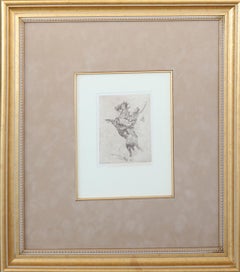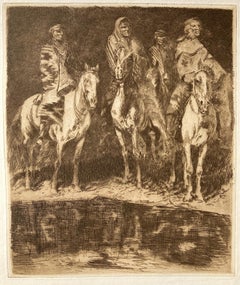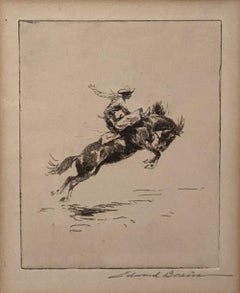Edward Borein Art
to
1
Overall Width
to
Overall Height
to
1
1
1
1
1
1
1
10,138
2,779
1,375
1,369
1
1
Artist: Edward Borein
Rearing Back
By Edward Borein
Located in Colorado Springs, CO
Original etching signed by the Artist.
Category
1940s Realist Edward Borein Art
Materials
Etching
Related Items
Les bouquinistes, with Notre Dame de Paris
By Luigi Kasimir
Located in San Francisco, CA
This artwork titled "Les bouquinistes, with Notre Dame de Paris" c.1930 is a color etching on wove paper by noted Austrian artist Luigi Kasimir, 1881-1962. It is hand signed in penc...
Category
Early 20th Century Realist Edward Borein Art
Materials
Etching
Vienna Concert Hall, Austria, large color etching
By Luigi Kasimir
Located in San Francisco, CA
This artwork titled "Vienna Concert Hall, Austria" c.1930 is a color etching on watermarked Kasimir Vienna paper by Austrian artist Luigi Kasimir, 1881-...
Category
Early 20th Century Realist Edward Borein Art
Materials
Etching
$850
H 30.75 in W 25.65 in D 0.01 in
Canoe - Peter Doig, Contemporary, 21st Century, Etching, Magic Realism, Edition
By Peter Doig
Located in Zug, CH
Canoe - Peter Doig, Contemporary, 21st Century, Etching, Magic Realism, Limited Edition
Edition of 500
Signed and numbered, accompanied by Certificate of Authenticity
In mint conditi...
Category
Early 2000s Realist Edward Borein Art
Materials
Etching
$2,498 Sale Price
68% Off
H 23.43 in W 29.53 in
Turmgasschen
By Luigi Kasimir
Located in San Francisco, CA
This artwork titled "Turmgasschen" 1935 is an original color etching by Austrian artist Luigi Kasimir 1881-1962. It is hand signed in pencil at the lower center by the artist and titled in the plate. The plate mark (image) size is 15.5 x 10 inches, framed is 24.35 x 17.5 inches. It is custom framed in a dark wood frame, with light creme color matting and light brown filet. It is in very good condition, the frame have some scratches.
Luigi Kasimir was born in 1881 at Pettau, today Ptuj, Slovenia, then a part of the Austro-Hungarian monarchy. He inherited his talent from his ancestors; his grandfather was a painter and a poet, and his father an officer in the Habsburg army, who later became a professional painter. Kasimir attended the Vienna Academy of Art where he studied under Wilhelm Unger, who introduced him to the technique of the coloured etching, and also to his future wife, the artist Tanna Hoernes.[1] He died in 1962 in Grinzing, a suburb of Vienna.Kasimir was among the first to develop the technique of the coloured etching. Before this, prints were usually hand-coloured with the colour being applied in a casual, haphazard manner. Kasimir would first create a sketch usually in pastel, he then transferred the design on as many as four to six plates, printing one after the other and applying the colour on the plate, all done by hand.
Kasimir is mainly famous for his etchings, but he also produced some oil painting, as well as some pastels. One of his favourite genres was the landscape, or veduta. He demonstrated a predisposition street scenes, and tourist landmarks. He depicted places from all over Europe, mainly Italy, Austria, and Germany. He also travelled to the United States to do a series of etchings of famous sights ranging from urban landmarks such as New York City skyscrapers, to natural wonders like Yosemite Valley. Luigi Kasimir’s etchings...
Category
Early 20th Century Realist Edward Borein Art
Materials
Etching
The original Whitney, Marcel Breuer Building (now Sotheby's), Woodcut engraving
By Richard Haas
Located in New York, NY
Richard Haas
The Whitney (Marcel Breuer Building), 1979
Woodcut engraving
Signed, titled, dated and numbered by the artist on the back. This is a rare Artist Proof 9/10, aside from ...
Category
1970s Realist Edward Borein Art
Materials
Engraving, Etching
$2,500
H 22.75 in W 18.25 in
Dancer Kity Harding
By Max Pollak
Located in San Francisco, CA
This artwork titled "Kity Harding" (c. 1950) is an original etching by noted Czech/American artist Max Pollak (1886 - 1970) It is hand signed and titled in pencil by the artist. The ...
Category
Mid-20th Century Realist Edward Borein Art
Materials
Etching
Mystery Signed Etching
Located in San Francisco, CA
Masterfully executed etching which is signed but is illegible. The contrast of shadows and sunlight in doorway is particularly well done. Background figures could be Dutch. Etching ...
Category
Early 20th Century Realist Edward Borein Art
Materials
Etching
Klosterneuburg, Austria
By Luigi Kasimir
Located in San Francisco, CA
This artwork titled "Klosterneuburg, Austria" c.1950 is a color etching by Austrian artist Luigi Kasimir 1881-1962. It is hand signed by the artist's estate in pencil at the lower center. The plate mark (image) size is 7.75 x 5.85 inches, framed is 18.15 x 15.15 inches. It is framed in a wooden antique silver frame. It is in very good condition.
About the artist.
Luigi Kasimir was born in 1881 at Pettau, today Ptuj, Slovenia, then a part of the Austro-Hungarian monarchy. He inherited his talent from his ancestors; his grandfather was a painter and a poet, and his father an officer in the Habsburg army, who later became a professional painter. Kasimir attended the Vienna Academy of Art where he studied under Wilhelm Unger, who introduced him to the technique of the coloured etching, and also to his future wife, the artist Tanna Hoernes.[1] He died in 1962 in Grinzing, a suburb of Vienna.Kasimir was among the first to develop the technique of the coloured etching. Before this, prints were usually hand-coloured with the colour being applied in a casual, haphazard manner. Kasimir would first create a sketch usually in pastel, he then transferred the design on as many as four to six plates, printing one after the other and applying the colour on the plate, all done by hand.
Kasimir is mainly famous for his etchings, but he also produced some oil painting, as well as some pastels. One of his favourite genres was the landscape, or veduta. He demonstrated a predisposition street scenes, and tourist landmarks. He depicted places from all over Europe, mainly Italy, Austria, and Germany. He also travelled to the United States to do a series of etchings of famous sights ranging from urban landmarks such as New York City skyscrapers, to natural wonders like Yosemite Valley. Luigi Kasimir’s etchings...
Category
Early 20th Century Realist Edward Borein Art
Materials
Etching
Lindau, Germany
By Luigi Kasimir
Located in San Francisco, CA
This artwork titled "Lindau, Germany" c.1950, is a color etching 0n Wove paper by noted Austrian artist Luigi Kasimir 1881-1962. It is hand signed in pencil by the artist at the lowe...
Category
Early 20th Century Realist Edward Borein Art
Materials
Etching
Aggstein Castle on the Danube
By Luigi Kasimir
Located in San Francisco, CA
This artwork titled "Aggstein Castle on the Danube" 1915 is a color etching on wove paper by noted Austrian artist Luigi Kasimir, 1881-1962. It is hand signed in pencil by the artis...
Category
Early 20th Century Realist Edward Borein Art
Materials
Etching
A Galway Peasant (also, An Irish Peasant)
By Gerald Leslie Brockhurst
Located in New York, NY
Gerald Brockhurst (1890-1978), A Galway Peasant (also, An Irish Peasant), etching, 1920, signed in pencil lower right. Reference: Fletcher 10, from the edition of 55, third state (of...
Category
1920s Realist Edward Borein Art
Materials
Etching
Heiligenblut, Austria
By Luigi Kasimir
Located in San Francisco, CA
This artwork titled "Heiligenblut, Austria" c.1950 is a color etching by Austrian artist Luigi Kasimir 1881-1962. It is hand signed by the artiste's estate in pencil at the lower center. The plate mark (image) size is 7.75 x 5.75 inches, framed is 17.85 x 15.15 inches. It is framed in a wooden antique silver frame. It is in very good condition.
About the artist.
Luigi Kasimir was born in 1881 at Pettau, today Ptuj, Slovenia, then a part of the Austro-Hungarian monarchy. He inherited his talent from his ancestors; his grandfather was a painter and a poet, and his father an officer in the Habsburg army, who later became a professional painter. Kasimir attended the Vienna Academy of Art where he studied under Wilhelm Unger, who introduced him to the technique of the coloured etching, and also to his future wife, the artist Tanna Hoernes.[1] He died in 1962 in Grinzing, a suburb of Vienna.Kasimir was among the first to develop the technique of the coloured etching. Before this, prints were usually hand-coloured with the colour being applied in a casual, haphazard manner. Kasimir would first create a sketch usually in pastel, he then transferred the design on as many as four to six plates, printing one after the other and applying the colour on the plate, all done by hand.
Kasimir is mainly famous for his etchings, but he also produced some oil painting, as well as some pastels. One of his favourite genres was the landscape, or veduta. He demonstrated a predisposition street scenes, and tourist landmarks. He depicted places from all over Europe, mainly Italy, Austria, and Germany. He also travelled to the United States to do a series of etchings of famous sights ranging from urban landmarks such as New York City skyscrapers, to natural wonders like Yosemite Valley. Luigi Kasimir’s etchings...
Category
Early 20th Century Realist Edward Borein Art
Materials
Etching
Previously Available Items
Navajos At The Water Hole
By Edward Borein
Located in Santa Monica, CA
EDWARD BOREIN (1782 - 1945)
NAVAJOS AT THE WATER HOLE, NO 1 (Galvin 181)
Etching, Stamped signature below the platemark at right faded. Image 11 7/...
Category
1920s American Realist Edward Borein Art
Materials
Etching
BRONCO BUSTER EDWARD BOREIN CIRCA 1908 ETCHING NICE! WESTERN COWBOY RODEO
By Edward Borein
Located in San Antonio, TX
Edward Borein
(1872-1945)
California Artist
Image Size: 5 x 4
Frame Size: 14 x 12
Medium: Etching
Circa 1908
"Bronco Buster"
Biography
Edward Borein (1872-1945)
Born in San Leandro, California, Edward Borein became one of the most popular artists of western scene painting, equally adept at ink drawing, watercolor, and etching.
He was raised in San Leandro, a western cow town, in a family where his father was a county politician. Edward had many childhood memories of herded cattle and their cowboys, which he began sketching at the age of five. He was educated in the Oakland, California schools, and at the age of 17 began working on a ranch near Oakland and then drifted and sketched as a working cowboy throughout the Southwest, Mexico, and Guatemala.
It was said that he practiced his art on anything he could find from bunkhouse walls to scraps of paper. At age 19, he enrolled at the San Francisco Art School, his only formal art training, and there he met Jimmy Swinnerton and Maynard Dixon who encouraged him in his art career.
The first person to purchase his work was Charles Lummis, editor of The Land and Sunshine magazine in California, and the two became life-long friends. Borein and Lucille Maxwell were married in the Lummis home. Borein, a typical westerner in dress and manner, also became close friends with Charles Russell, actor Will Rogers, and President Theodore Roosevelt. Borein often traveled north to visit Russell in Great Falls, Montana and to travel among Indian tribes.
In 1899, Borein visited Arizona while returning from Mexico. By 1902, he was a successful illustrator in San Francisco for the San Francisco Call, and in 1907 to enhance his illustration skills, went to New York to learn etching techniques. There he enrolled in the Art Students League and was a student of Child Hassam. In the theatre district, he opened a studio that became a gathering place for 'lonesome' westerners such as Charles Russell, Will Rogers, Olaf Seltzer...
Category
Early 1900s Impressionist Edward Borein Art
Materials
Etching
New Bucking Horse
By Edward Borein
Located in Myrtle Beach, SC
'New Bucking Horse', etching, c. 1916, edition not stated, Galvin 72. Signed in the plate, lower right. A fine impression, in warm black ink, on pale, buff wove paper, with full margins (1 1/4 to 1 3/4 inches), in very good condition. Image size 8 x 5 inches; sheet size 11 1/8 x 8 1/8 inches. A rarely seen image, very scarce. Matted to museum standards. Unframed.
The cowboy's work of breaking wild horses into riding horses evolved into the competitive sport of professional rodeo in the 1880s. Borein created some 32 etchings on the subject of cowboys breaking horses and bucking bronco rodeo riders.
ABOUT THE ARTIST
No other artist captured the "disappearing West" with the authenticity and spirit of John Edward Borein (1872-1945). A native of the San Francisco Bay Area, Borein rode south in 1893 at the age of twenty-one, and over the next few years, worked his way through California and the vast stretch of Mexico. On the range, the young cowboy sketched...
Category
1910s American Realist Edward Borein Art
Materials
Etching
Trail Herd, No. 2
By Edward Borein
Located in Santa Monica, CA
EDWARD BOREIN (America 1872 - 1945)
TRAIL HERD No. 2. c. 1920-25 (Galvin 101)
Etching, unsigned, but a lifetime impression. Platemark 6 7/8 x 12 5/8 inches. On thin laid paper, sh...
Category
1920s American Realist Edward Borein Art
Materials
Etching
'Scratchin' High' — early American rodeo
By Edward Borein
Located in Myrtle Beach, SC
'Scratchin' High', etching, edition not stated, c. 1919. Signed in pencil. A fine, rich impression, in warm black ink, on cream wove paper, with margins (11/16 to 2 1/8 inches). Two small spots of toning in the bottom right margin, away from the image; barely visible printing creases in the top left margin and the middle right background, otherwise in very good condition. Matted to museum standards, unframed.
ABOUT THIS WORK
The cowboy's work of breaking wild horses into riding horses evolved into the competitive sport of professional rodeo in the 1880s. In 1919 at the Calgary Stampede in Alberta, Canada, Borein sketched a rider on the famous bucking horse named 'I-See-U'. He later made this etching of the dramatic scene, entitling it 'Scratchin' High'. ''Scratching'' refers to the rider's technique of maintaining balance on a bucking horse by a continuous movement of the feet in a kicking motion.
Impressions of this work are in the permanent collections of the Buffalo Bill Center of the West (online), and the Whitney Western Art Museum.
ABOUT THE ARTIST
No other artist captured the "disappearing West" with the authenticity and spirit of John Edward Borein (1872-1945). A native of the San Francisco Bay Area, Borein rode south in 1893 at the age of twenty-one, and over the next few years, worked his way through California and the vast stretch of Mexico. While on the range, the young cowboy sketched...
Category
1910s American Realist Edward Borein Art
Materials
Etching
TAOS, NEW MEXICO (Rare)
By Edward Borein
Located in Santa Monica, CA
EDWARD BOREIN (1872 – 1975)
TAOS (aka (Oven), Taos New Mexico (Gavin 234)
Etching, with platetone. 7 7/8 x 13 ¾. Unsigned. Large f...
Category
1920s American Realist Edward Borein Art
BREAKNECK TRAIL TO WALPI, NO. 2
By Edward Borein
Located in Santa Monica, CA
JOHN EDWARD BOREIN (1872 - 1945)
BREAKNECK TRAIL TO WALPI, No. 2 (Galvin 214)
Etching, signed in pencil, 12 1/2 x 8 7/8, sheet 13 1/2 x 9 3/4. Small
m...
Category
1920s Realist Edward Borein Art
Materials
Etching
Mission Santa Barbara, No. 3
By Edward Borein
Located in Santa Monica, CA
JOHN EDWARD BOREIN (1872 - 1945)
MISSION SANTA BARBARA, No 3, c.1920 (Galvin 250)
Etching, Signed in pencil. 8 1/2 x 14 1/...
Category
1920s American Realist Edward Borein Art
Materials
Etching
Edward Borein art for sale on 1stDibs.
Find a wide variety of authentic Edward Borein art available for sale on 1stDibs. You can also browse by medium to find art by Edward Borein in etching and more. Not every interior allows for large Edward Borein art, so small editions measuring 5 inches across are available. Customers who are interested in this artist might also find the work of John Sloan, Jerome Myers, and George Biddle. Edward Borein art prices can differ depending upon medium, time period and other attributes. On 1stDibs, the price for these items starts at $3,200 and tops out at $3,200, while the average work can sell for $3,200.


